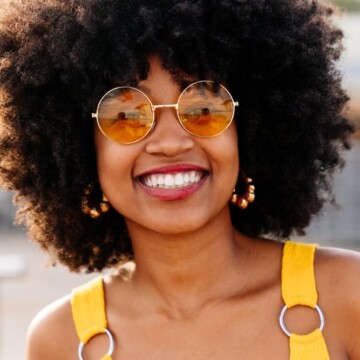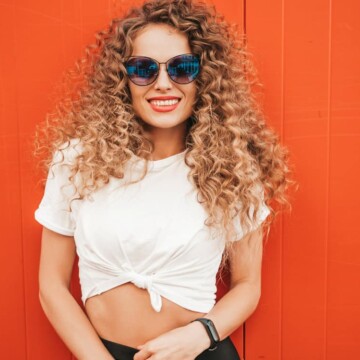
Dyeing your hair is an excellent way to show off your creativity and express yourself. However, it can be exceedingly expensive, time-intensive, and damaging to your hair.
Jello is a hair dyeing method that bypasses just about all of the issues one could encounter from traditional hair dye. But how exactly do you go about it? How do you get the best results? In this article, we’ll how to dye hair with Jello and much more!
Table of Contents
Who Should Dye Their Hair With Jello?
Jello doesn’t contain harsh chemicals and is gentle enough for every hair type. From virgin curls to color-treated kinks, jello is a safe option. Only those with significant protein or food dye sensitivities should avoid this method.
Note: Jello hair dye is better suited for lighter hair tones than it is for dark hair. If you have dark hair and want noticeable color, bleaching your hair beforehand is recommended. Read this article to learn how to bleach dark hair without causing damage.
What You Should Expect When Dyeing Hair With Jello

Jello is less pigmented than hair dye, so the color will be soft and less vibrant. Results will last anywhere from 2 to 5 weeks, depending on how light your hair is and how often you wash your hair after coloring.
The color you achieve will also vary depending on your hair's porosity. High porosity hair has a lot of openings and accepts color more easily; low porosity hair, on the other hand, can be color resistant.
Note: Very light and bleached hair may hold onto color for longer than 5 weeks.
How to Dye Your Hair with Jello
The following steps will demonstrate how to dye your hair with Jello. If you have dark hair and don’t want to bleach it beforehand, you can use light-colored
Materials:
- 1 or 2 boxes of Jello in your desired color
- Petroleum jelly (recommended)
- Thick hair conditioner
- Latex or vinyl gloves
- Shower cap
- Bowl (1 per color)
- Applicator brush (optional)
- Aluminum foil (for colored streaks)
- Hair clips or hair ties
Steps
- Start with clean, dry hair. Make sure your hair is freshly clarified (washed with a clarifying shampoo) and dried. Avoid using styling or moisturizing products before dyeing. Doing so will eliminate any barriers that could prevent the dye from taking. Although you can also start with damp hair, dry hair will absorb the color better.
- Prepare your area. Lay down old towels or newspaper on the floors and surfaces to protect against splatter. Wear gloves and clothes you don’t mind getting stained.
- Mix the Jello with the hair conditioner. Use one bowl for each desired color. Mix each packet of Jello with a liberal amount of hair conditioner (at least ½ a cup). For long or very thick hair, use 2 packets of Jello. The consistency should be thick, so it clings to your hair and doesn’t drip.
- Put petroleum jelly around the perimeter of your hairline and ears. This step prevents the dye from staining your skin. You don’t need to use a lot; a thin layer of petroleum jelly will be sufficient.
- Divide your hair into sections. If you want streaks of color, separate the sections you want to color from the rest of your hair. If you’d like to color your entire head, separate your hair into 4 separate sections using hair clips or ties. This makes the coloring process easier to manage.
- Spread the Jello mixture onto your hair. Apply the mixture liberally to any hair you want to dye. You can use an applicator brush for precision, but your fingers may suffice. Once one section is fully saturated with color, wrap it into a bun and secure it with your clips or ties. If you’re coloring small streaks of hair, wrap each finished portion in tinfoil to keep the color in place and prevent it from spreading.
- Put the shower cap on. The shower cap will both prevent your hair from drying out and trap body heat. Heat allows the color to penetrate your hair more deeply. Using a shower cap also prevents the dye from dripping or transferring to your clothes as you wait.
- Wait. Let the mixture sit on your hair for at least an hour. The longer you leave it on, the bolder your color result will be.
- Rinse the Jello out of your hair with lukewarm water. Rinse your hair thoroughly to remove as much excess dye as possible. Do not use shampoo or conditioner immediately after dyeing, as that will strip the color from your hair. The conditioner you mixed with the Jello should be enough to keep your hair moisturized.
- Dry your hair. If you use a towel, make sure it’s made of microfiber material and that you’re ok with it getting stained, as some of the color may transfer onto it.
- Style as normal.
How to Remove Jello From Hair

Whether you aren’t happy with your hair color or you’re just ready for a change, you may want to remove your Jello hair dye before it wears off. To remove the color, you can wash your hair with a clarifying shampoo (or another deep cleaning shampoo).
For more stubborn color, mix 1 teaspoon baking soda with a small amount of water. Apply the mixture to your hair and wait for 10 minutes before rinsing off. You can repeat this process once a week until the hair color has faded completely.
How to Remove Jello Stains
Despite taking precautions, you may find some stains after you dye your hair. Treat them as quickly as possible to prevent them from permanently setting.
For fabrics: Immediately blot with cold water. Hot water and vigorous rubbing will only cause the stain to set. For more stubborn stains, dab the area with plain rubbing alcohol or an oxygen-based bleaching agent–like OxiClean–and add it to your next load of laundry.
For hard surfaces: Quickly wipe the area with your preferred household cleaner. If the stain persists, make a thick paste out of baking soda and water. Let the paste sit for 10 minutes before gently wiping it away.
Pros and Cons of Dyeing Hair with Jello

While dyeing hair with Jello may be a great alternative for some, it’s not for everyone. Here are some pros and cons to help you decide if coloring your hair with Jello is right for you.
- Inexpensive. A box of Jello costs less than $2 on average, and many people already have hair conditioner on hand. This is much more affordable than traditional hair dyes.
- Lots of variety. Jello has a lot of different flavor and color variations, so the color possibilities are endless! You can even try mixing multiple boxes to get a specific shade.
- Less damaging. Jello doesn’t have ingredients like peroxide or ammonia, so it won’t damage your hair like traditional hair dyes.
- Can reduce breakage. The main ingredient in Jello is gelatin, which is a type of protein. Using protein on your hair can help decrease breakage, rebuild elasticity and lead to stronger hair.
- Less intense color. The food coloring in Jello isn’t as strongly pigmented as what you’d find in hair dyes. This results in softer, more pastel color. On dark hair, the color may not show up at all.
- Color can bleed. Dyeing your hair with jello is a messy process. Even after your hair is completely dried, the dye can still transfer onto your scarves, pillowcases, hats, and bonnets.
Dos and Don’ts of Dyeing Hair With Jello

When dyeing your hair with Jello, there are a few things to keep in mind. Below is a list of dos and don’ts to help make sure your dyeing process goes as smoothly as possible.
- Don’t start with dirty hair. Hair products can act as a barrier and prevent the hair strands from absorbing color. Starting with clean hair helps ensure the Jello will deposit as much color as possible.
- Do protect your area. The color in Jello comes from added food dyes, which can stain skin, fabrics, and surfaces. Make sure you’re using towels and clothing you don’t mind getting stained, and lay down old towels or newspapers to prevent splatter.
- Do know what to expect. As mentioned before, hair porosity greatly affects how well your hair takes and holds onto the color. Hair porosity can vary in different portions of your hair. For example, your ends may be much more porous than your roots. This means the color may come out uneven and patchy.
- Do have fun! Jello is inexpensive and gentle on hair, which means you can have fun without worrying about breaking the bank or ruining your hair. You can layer colors, dye just your roots or ends, or experiment by adding more or less Jello powder to adjust the shade.
- How To Do Professional Hair Color at Home
- Best Vegan Cruelty-Free Hair Dyes
- How To Get Kool-Aid Out of Your Hair Fast
- How To Use Henna Hair Color Powder
We hope this article has given you some insight into dyeing your hair with Jello. It can be a fun and inexpensive way to experiment with color without damaging your hair.
You can try out colors before committing to a permanent or semi-permanent hair dye or simply rock a temporary look. Either way, Jello can be a fun and unexpected addition to your hairstyling routine.




